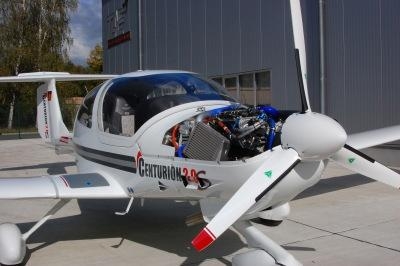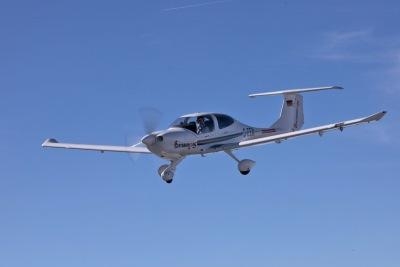Fri, Oct 28, 2011
Order Book Is Open And Production Is Underway
EASA has certified The 155 hp Centurion 2.0s power pack for
retrofit into the Diamond DA40 TDI. The engine can be installed as
a direct replacement for the Centurion 1.7 or Centurion 2.0 (both
135 hp mills) under the DA40s existing cowling. Diamond DA40
operators using a Centurion engine can now choose between two
replacement engines: the well-known, fuel-efficient Centurion 2.0
and the more powerful Centurion 2.0s.

EASA authorized the retrofit at the beginning of September 2011,
and production of the new Centurion product has already been
launched. Orders are being accepted now, and deliveries are
expected to begin by the end of November. The Diamond DA40 is the
third aircraft model — after the Cessna 172 and Robin DR400
— that can be equipped with the Centurion 2.0s. Certification
for the Piper PA-28 is expected soon.
The Centurion 2.0s is a more powerful version of the Centurion
2.0. It has identical weight and dimensions as the 135 hp model,
but offers 20 more horsepower. At 100 percent load, the DA40 with
the engine upgrade can reach a top cruising speed of 148 KTAS
through 8,000 ft. The average fuel consumption during flight is
just under 6 gallons (US) per hour at a speed of 128 KTAS (70%
power @ 6,000 ft.). The airplane equipped with the new engine will
climb at 800 ft/min through 6,000 feet, and comes off the runway in
just over 1,000 feet. The range with a standard 28 US gallon tank
is 475 NM (all values with MTOW and standard ISA). The maximum
takeoff weight is 2,535 pounds.

Like all aircraft equipped with a Centurion engine, the DA40
also has a fully electronic engine and propeller control system
with single-lever control. The time between replacement (TBR) for
the Centurion 2.0s is currently still 1,200 flight hours. The goal
is to extend the TBR to 1,500 hours, as it is the case for the
Centurion 2.0.
Centurion is also pursuing additional plans for the Centurion
2.0s. Certification of the 155 hp version for the Piper PA-28 is
already being pursued. “With the market launch of the
Centurion 1.7 in 2002, we provided the decisive stimulus for the
development of alternative propulsion systems for small aircraft.
So far, the currently series-produced Centurion 2.0 and Centurion
2.0s successor models account for 1.4 million flight hours. In sum,
well over 3,000 Centurion engines have been delivered so
far,” said Centurion’s CEO Jasper M. Wolffson.
More News
Aero Linx: Model Aeronautical Association of Australia MAAA clubs are about fun flying, camaraderie and community. For over 75 years, the MAAA has been Australia’s largest fl>[...]
Touchdown Zone Lighting Two rows of transverse light bars located symmetrically about the runway centerline normally at 100 foot intervals. The basic system extends 3,000 feet alon>[...]
“Discovery and innovation are central to our mission at Virgin Galactic. We’re excited to build on our successful record of facilitating scientific experiments in subor>[...]
How To Get A Story On Aero-TV News/Feature Programming How do I submit a story idea or lead to Aero-TV? If you would like to submit a story idea or lead, please contact Jim Campbel>[...]
Student Pilot Reported That During Rotation, “All Of A Sudden The Back Of The Plane Kicked To The Right..." Analysis: The student pilot reported that during rotation, “>[...]
 ANN's Daily Aero-Linx (05.02.24)
ANN's Daily Aero-Linx (05.02.24) ANN's Daily Aero-Term (05.02.24): Touchdown Zone Lighting
ANN's Daily Aero-Term (05.02.24): Touchdown Zone Lighting Aero-News: Quote of the Day (05.02.24)
Aero-News: Quote of the Day (05.02.24) ANN FAQ: Contributing To Aero-TV
ANN FAQ: Contributing To Aero-TV NTSB Final Report: Cirrus Design Corp SR20
NTSB Final Report: Cirrus Design Corp SR20




